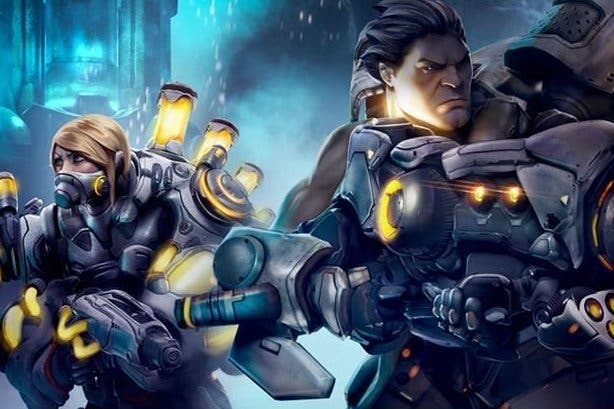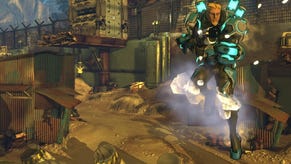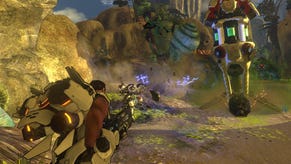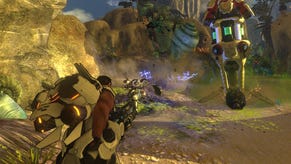Firefall review
Flame on?
To grind or not to grind? For Red5's long-gestating Firefall, that is very much the question. As a game that is both massively multiplayer and free to play, Firefall is squeezed on both sides by the need to stretch, pad and otherwise elongate the player's journey in order to keep them playing - and hopefully get them paying.
It's also a game that has made huge advances since I last checked in on it this time last year. Back then, it was a sort of formless mush of potentially interesting ideas, let down by baggy pacing and distractingly complex systems. In the intervening 12 months, and with the game now officially launched, those ideas have come into better focus, and while there are still issues with pace, balance and fiddly bits, it's finally a game that is enjoyable to play.
You still play as an ARES operative, a mercenary plying your trade on a future Earth forever changed by a terrible meteor impact, a tragic accident in which the first "arc-folding" deep space vessel crashes into Brazil, and the subsequent opening of a dimensional rift called The Melding through which pours a zealous alien army called The Chosen. Keeping the peace is The Accord (everything starts with "The" in Firefall) and it's this UN-style organisation you'll be doing most of your work for.
This is an MMO shooter, but unlike most similarly themed games which immediately gravitate towards PVP combat, Firefall's initial launch skews the other way and strongly favours PVE play. You'll fill your time by undertaking jobs, selected from the obligatory job boards in the various outposts dotted around the game's colourful South American starting zone. These jobs are familiar and, frankly, boring. Head to a location and kill X number of alien bugs and molluscs, or human enemies such as bandits and gangs. Then head back again.
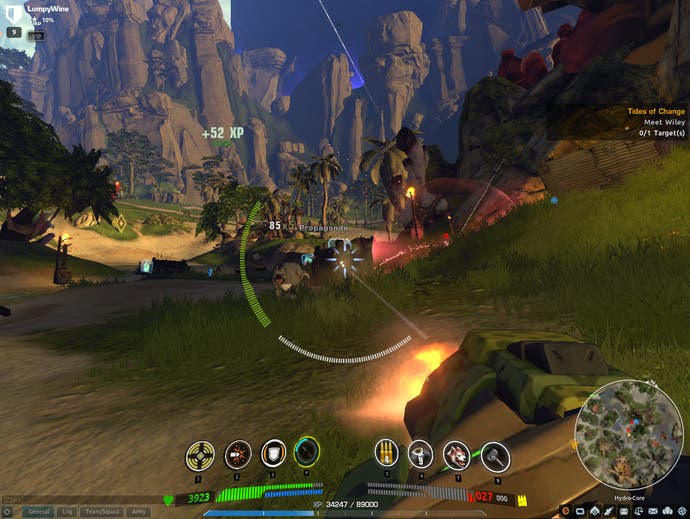
The combat itself is solid enough, though rarely inspired. I opt to start my game wearing the Dreadnaught Battleframe; Battleframes are suits of armour that double as your player class. Dreadnaught is basically the tank equivalent, so I get to wield a giant minigun. Tearing through low-level enemies is fun but quickly becomes repetitive.
Though the guns themselves handle well, there's not a lot of feedback from the world when you let rip. Enemies, even of the human variety, exhibit only the crudest AI and will stand there and shoot back at you while you empty dozens of rounds into them with no apparent effect other than hit points spurting into the air.
That's true across all the classes, which cover the expected spread of MMO types. Assault is your standard soldier class, ideal for those with no imagination. Engineers can spawn turrets and restock ammo. Biotechs are the healer class and also use poison gas against enemies. Recon is the traditional sniper slot, inherited from the game's shooter roots. Each comes with its own weapon set and hotkey abilities that unlock as you level up. There are also multiple sub-classes for each Battleframe, allowing you to specialise further the deeper you get.
The game is pleasingly agnostic regarding classes, though. If you want to try a different style of play, you simply swap to a different Battleframe at stations all over the map. You'll need to level up each one individually, but it means that you don't need to have multiple characters on the go.
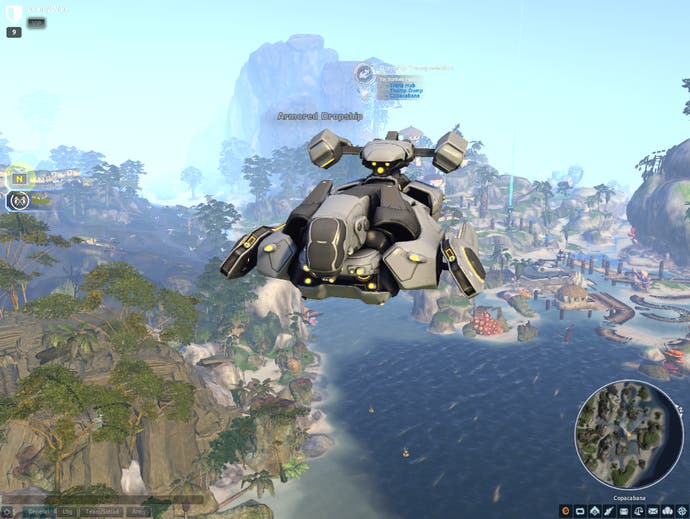
The decision to downplay PVP means that the difference between classes is fairly academic, at least for a sizeable chunk of the early game. You won't be coming up against enemies that require any tactics, which also means that teamwork is far from essential in those vital opening days of play. It's only much later, when you're ready to venture into Titan Lairs and the like, that you'll need to put much thought into squad strategies. You'll mostly be romping around the colourful world, playing alongside others but only occasionally playing with them.
This is most likely to happen when using Thumpers. These mining rigs can be summoned from the sky to gouge resources out of the soil after you've prospected with your Scan Hammer, which whacks the ground and reveals the mineral deposits beneath. You then call in a Thumper and keep it safe while it fills up.
The ore you mine can be processed at research stations and then crafted into new gear. Very slowly. As in the beta, the research and crafting functions are where you'll get the best kit, but the game's drab and often opaque menus still do a really bad job of explaining what, precisely, you're getting.
It's also here that the free-to-play mechanisms are, inevitably, most felt, as build times vary from seconds to hours depending on the usefulness of what you want to make. You can, of course, speed it up at any time by spending Red Beans, Firefall's premium currency.
You can earn Red Beans in-game by converting the game's base currency (Crystite) into an intermediary currency (Credits) and from there into Red Beans, but the exchange rate would make even the greediest high street bank weep in envy. If you're planning on funding your game through grinding and farming, you won't be doing much else. The game's markets aren't cheap, either.
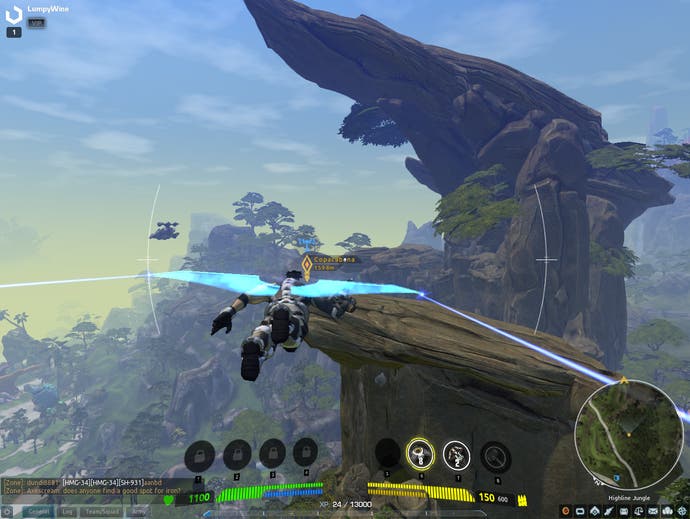
The smallest amount of Red Beans you can buy is 57, which is equivalent to £5. Cosmetic items range from hairstyles for 10 Beans to extravagant masks for 200. A Cobra bike will set you back 175 Red Beans, or the best part of 20 quid. Those advanced sub-class Battleframes are 100 beans to unlock.
What you can't do is buy overpowered weapons, but you can purchase 60-minute XP and reputation boosts for 10 Beans (you also get a similar bonus for free every consecutive day you play). Alternatively, you can fork out for VIP membership which gives you a constant 25% boost to XP, Crystite and Reputation earned. That's 40 Beans per week, or at the top end of the scale it's 950 for a whole year. That works out just shy of £100, which is cheaper than a subscription MMO, although its relative value is arguable.
As with any free-to-play system, what Firefall's Red Beans do is draw a line between those who are willing to pay for the fun toys and those who are still grinding away earning stuff slowly via the old-fashioned route. That's not a massive problem - except where mobility is concerned.
Firefall is pretty massive but is visually inconsistent. It can muster some lovely vistas, yet textures are grubby and blurred up close. Character models are fairly hideous and there's a spasmodic feel to the proceedings as waypoints load in more slowly than the speech explaining them and button responses are sluggish.
The game world is large, so getting around is a real slog. You have jet boots, which can give you a bit of lift and forward momentum, or you can make use of glider pads, situated high up on friendly buildings. These punt you into the air and then let you swoop majestically towards your waypoint. Both are enormous fun to use (even if Tribes fans will find it nothing new) but are still not enough to make getting from A to B less of a chore.
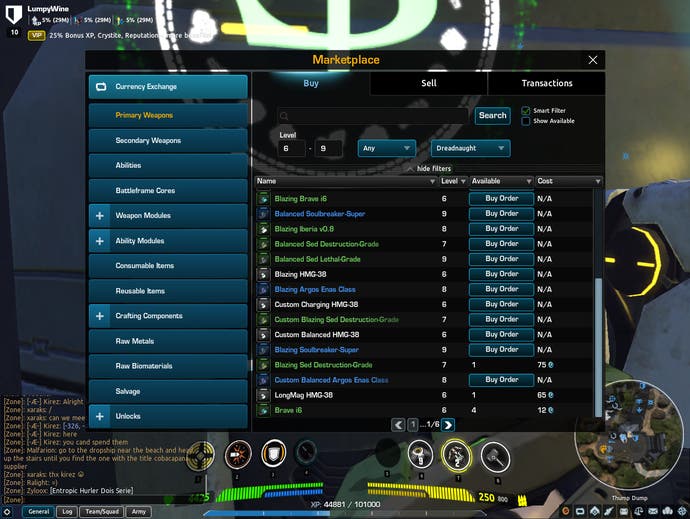
Too many missions involve jogging 700m to one waypoint only to be sent 900m to another and then 800m back to the start. Each time means minutes of chugging through the admittedly lovely but largely empty scenery. At best, along the way you'll be attacked by some low-level enemies or come across a crashed Thumper to fix. The world certainly doesn't feel alive or organic, which makes that early climb through the initial levels feel like a real slog - particularly if you're swapping a levelled-up Battleframe for a new one and having to replay the exact same side missions that you've already cleared just to get up to speed.
This dearth of meaningful content can't help but exacerbate the game's general lack of character. It looks striking enough, though colourful worlds are less distinctive in MMOs than they are in shooters. But it's hard to feel like you're part of the world. The emphasis on Battleframes rather than your character means that your avatar is a fairly abstract thing: you may be able to give it a mohawk or a giant straw hat, but it's never really a character in the way that your favourite Warcraft creations are.
This is partly due to the fact that Firefall is primarily a shooter, not a role-player. Unlike the swords, axes and staffs of a fantasy RPG, guns always tend to have a flattening effect on this sort of thing and, much like the similarly themed Defiance, Firefall struggles to offer genuine options beyond variations on the space marine. For all its premium-rate personalisation, everyone is playing as a human in battle armour and nobody really stands out.
There's plenty to like in Firefall, but not much to love - and that's the passion it needs to evoke in order to get you spending on those Red Beans that will open up the game's more interesting tools and let you progress faster, both upwards through the levels and through the world itself. It's a game I found myself enjoying in ever shorter bursts as the prospect of farming more XP and Crystite from yet another nest of alien bugs, or finding another lost family member for a crudely modelled NPC, became less and less enticing. If Red5 can fix the pace, there's a potentially worthwhile game here. Right now, it just doesn't offer a compelling reason to spend your time, let alone your money.
